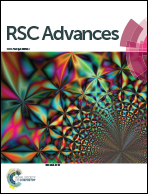Use of caprylic/capric triglyceride in the encapsulation of dementholized peppermint fragrance leading to smaller and better distributed nanocapsules†
Abstract
Dementholized peppermint (DP) fragrance nanocapsules were prepared through the interfacial polymerization of isophorone diisocyanate (IPDI) and hexamethylene diamine (HMDA) in a nanoemulsion, in which peppermint fragrance added with/without caprylic/capric triglyceride (GTCC) was used as the core material and polyurea as the shell material. The results showed that addition of GTCC can significantly reduce the sizes of nanocapsules and improve the size distribution of the nanocapsules. Under the optimized conditions, the resulting DP-GTCC nanocapsules kept good physical stability, while DP nanocapsule dispersion was physically separated in a short time. The average nanocapsule diameter was 82.8 nm with a narrow size distribution of 0.19. The nanocapsules possessed a high DP fragrance loading of 16% with encapsulation efficiency of 81%. Besides, the addition of GTCC further improved the thermal stability of the core material. DP-GTCC nanocapsule dispersion was very stable and exhibited good transparency at a nanocapsule concentration of 0.2% or less due to its very small size.


 Please wait while we load your content...
Please wait while we load your content...